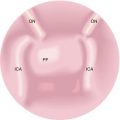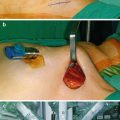Simple(nontoxic) goiter
Multinodular
Solitary thyroid nodule
Follicular adenoma
Thyroid cyst
Toxic goiter
Diffuse (Graves’ disease)
Toxic multinodular (Plummer’s disease)
Solitary toxic adenoma
Inflammatory goiter
Acute suppurative thyroiditis
Subacute (painless) lymphocytic, including postpartum thyroiditis
Subacute (painful) granulomatous or De Quervain’s thyroiditis
Chronic lymphocytic or Hashimoto’s autoimmune thyroiditis
Invasive fibrous (Riedel’s) thyroiditis
Developmental conditions
Thyroglossal duct cyst
Ectopic thyroid (lingual)
Rare causes of goiter
Amyloid goiter
Dyshormonogenetic goiter
Drug induced (lithium, amiodarone)
Simple (Nontoxic) Goiter
Multinodular goiter may affect up to 500–600 million people worldwide (Matovinevic 1983).
May be sporadic, endemic (in areas of iodine-deficiency), or, rarely, familial.
Majority of patients are euthyroid and asymptomatic; a slow, gradual (10–20 % per year) increase in volume is usual.
Follicular adenoma is a benign, encapsulated, noninvasive follicular cell neoplasm that may display only very subtle histopathologic differences from adjacent thyroid parenchyma.
Pathological variants include Hürthle cell adenoma, hyalinizing trabecular adenoma, and atypical follicular adenoma.
Since follicular adenomas cannot be differentiated from carcinomas using fine needle aspiration biopsy (FNAB), the term “follicular neoplasm” is used, and surgical excision is required to establish a definite diagnosis.
Thyroid cysts can be easily identified using thyroid ultrasonography.
They may be caused by a variety of etiologies (infectious, inflammatory, degenerative, neoplastic), although cystic degeneration within a multinodular goiter is the most common cause.
Toxic Goiter
Graves’ disease is a common autoimmune disorder characterized by antibodies (“thyroid-stimulating immunoglobulins”) which bind to the TSH-receptor, resulting in hyperthyroidism.
Clinical findings include the presence of a diffuse goiter, signs of hyperthyroidism (tachycardia, tremor, arrhythmia), and, in a minority, signs of ophthalmopathy.
Thyroid eye disease and pretibial myxedema differentiate Graves’ disease from other causes of hyperthyroidism.
Toxic multinodular goiter occurs typically in elderly subjects with a long-standing multinodular goiter (Plummer’s disease).
Occasionally solitary thyroid nodules can function autonomously leading to toxic thyroid adenomas.
Inflammatory Goiter
Hashimoto’s disease (chronic lymphocytic thyroiditis) is an organ-specific autoimmune disorder characterized by circulating antibodies directed against the thyroid peroxidase (TPO) or thyroglobulin (Tg) antigens. It is most common in middle-aged women.
Hashimoto’s thyroiditis may after many years progress to hypothyroidism and FNABs are characterized by lymphocytic infiltration and associated Hürthle cell metaplasia.
Thyroid lymphoma may very rarely develop in goiters affected by Hashimoto’s thyroiditis.
De Quervain’s thyroiditis is an inflammation of the thyroid, presumed secondary to a viral infection, that is associated with severe neck pain dramatically responsive to steroids.
Usually self-limiting over weeks and managed symptomatically.
Postpartum thyroiditis is a self-limiting subacute inflammation of the thyroid gland which affects approximately 10 % of pregnancies and may be recurrent with each pregnancy.
This results in permanent hypothyroidism in around 50 % of affected women.
Riedel’s struma or invasive fibrous thyroiditis is rare and associated with a painless stony hard irregular gland that can mimic an anaplastic cancer.
The cause is unknown, but it may be associated with other similar inflammatory sclerosing conditions such as retroperitoneal fibrosis or fibrous mediastinitis.
Developmental Conditions
Thyroglossal duct cysts are the most common upper neck midline lesions.
They are due to persistence of the stalk of epithelial cells that descend down from the floor of the primitive pharynx during development of the thyroid. The stalk normally undergoes atrophy at 6 weeks, but its persistence leads to cyst formation.
Stay updated, free articles. Join our Telegram channel

Full access? Get Clinical Tree





